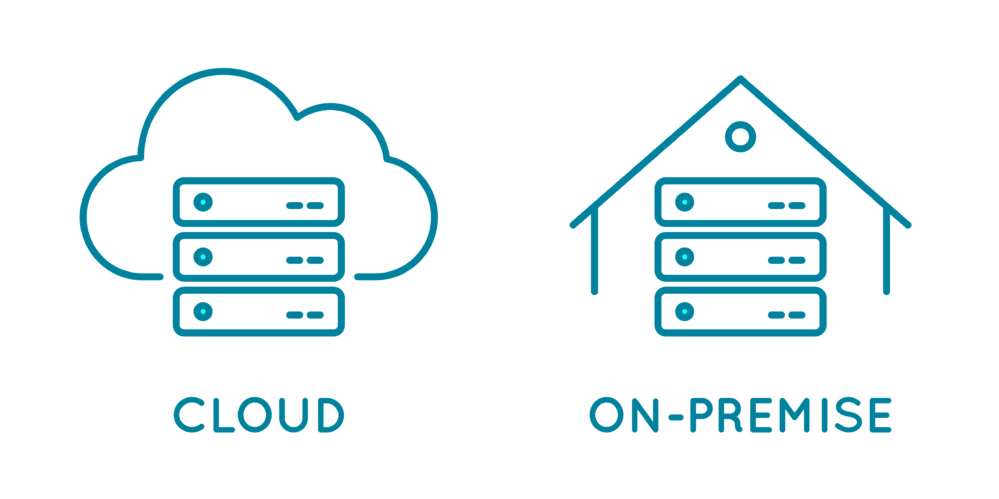Choosing between cloud and on-premise systems has become one of the most important technology decisions for modern businesses. As digital transformation accelerates, every company must decide whether to keep its data and applications on internal servers or move them to cloud platforms managed by external providers.
The choice affects everything from cost and scalability to data security and compliance. In this blog, we’ll explore how cloud and on-premise deployment models work, what sets them apart, and the key benefits and risks of each option. By the end, you’ll have a clearer view of which approach aligns best with your organisation’s goals and resources.
Understanding the Two Models: On-Premise and Cloud
Before comparing costs and benefits, it’s essential to understand how on-premise and cloud models differ in data storage, infrastructure management, and application delivery. This helps determine which model best fits your business needs.

What Is On-Premise?
On-premise refers to a traditional IT deployment model where all hardware, software, and data are hosted locally within a company’s own facilities. In this setup, the organization owns and maintains its physical servers, storage, and networking equipment, often housed in an in-house data center.
Businesses using on-premise infrastructure have full control over their systems, configurations, and security policies. However, this control comes with higher responsibilities. The company’s IT team must handle everything from hardware installation and maintenance to software updates, backups, and security management. This typically requires significant upfront investment in infrastructure and ongoing operational costs for maintenance, energy, and IT staff.
On-premise environments are often preferred by organizations that handle highly sensitive data or must comply with strict security and regulatory requirements, such as in finance, healthcare, or government sectors.
What Is Cloud Computing?
Cloud computing, on the other hand, is a model where computing resources such as servers, storage, databases, and applications are delivered over the internet by third-party providers. Instead of owning physical infrastructure, businesses “rent” these resources on demand and pay based on usage.
Cloud services are typically categorized into three main types:
- Infrastructure as a Service (IaaS): Provides virtualized computing resources, such as virtual machines and storage.
- Platform as a Service (PaaS): Offers tools and environments for developing, testing, and deploying applications.
- Software as a Service (SaaS): Delivers fully managed software applications accessible through web browsers.
This model enables businesses to scale resources quickly, access advanced technologies, and reduce the need for heavy upfront investment. Cloud providers are also responsible for system updates, uptime, and data security, allowing internal teams to focus on core business operations.
Cloud computing is highly suitable for organizations that prioritize flexibility, scalability, and accessibility across multiple locations or remote teams.
Key Differences Between Cloud and On-Premise
While both cloud and on-premise models aim to support business operations, they differ significantly in how resources are managed, deployed, and maintained. Understanding these distinctions helps organizations choose the most effective approach for their specific needs.

Infrastructure Ownership
- On-Premise: The business owns and manages all hardware, software, and networking components. Everything is stored and operated within the company’s physical premises.
- Cloud: Infrastructure is hosted by an external provider and accessed remotely via the internet. The business pays for resources based on usage rather than owning them.
Cost Structure
- On-Premise: Requires large upfront capital expenditure for servers, data centers, and IT staff. Maintenance and upgrade costs are ongoing.
- Cloud: Operates on a subscription or pay-as-you-go model, converting capital expenses into operational costs and reducing financial risk.
Scalability and Flexibility
- On-Premise: Scaling up often involves purchasing additional hardware and can take significant time and planning.
- Cloud: Resources can be scaled up or down instantly to match business demands, offering high flexibility and efficiency.
Security and Compliance
- On-Premise: Offers maximum control over data and security configurations, ideal for industries with strict compliance standards.
- Cloud: Security is shared between provider and client. Leading cloud vendors follow global compliance frameworks, but businesses must still manage access control and data governance.
Maintenance and Updates
- On-Premise: The internal IT team is responsible for system updates, patches, and troubleshooting.
- Cloud: Service providers handle maintenance, ensuring systems are always up to date with minimal downtime.
Accessibility and Collaboration
- On-Premise: Systems can only be accessed within the company’s local network unless additional remote access tools are configured.
- Cloud: Data and applications are accessible from anywhere with an internet connection, supporting remote work and real-time collaboration.
Benefits of Cloud and On-Premise Deployment Models
Each deployment model comes with distinct advantages that cater to different business goals and IT strategies. Understanding these benefits helps you identify which setup aligns best with your company’s priorities.

Benefits of Cloud Computing
- Cost Efficiency: Eliminates the need for upfront hardware investment, allowing businesses to pay only for the resources they use.
- Scalability: Enables rapid scaling of storage, processing power, or applications as business needs evolve.
- Accessibility: Offers easy access to systems and data from anywhere, supporting remote and hybrid work environments.
- Automatic Updates: Cloud providers manage updates and security patches, ensuring optimal performance with minimal IT effort.
- Disaster Recovery: Built-in redundancy and data backup features protect against data loss and ensure business continuity.
Benefits of On-Premise Infrastructure
- Full Control: Businesses retain complete authority over hardware, data, and system configurations.
- Enhanced Security: Sensitive data remains within company walls, reducing exposure to external threats.
- Compliance Assurance: Easier to meet specific industry regulations requiring local data storage or physical control.
- Customization: Systems can be tailored to exact business requirements without depending on third-party limitations.
- Stable Performance: On-premise setups can offer consistent performance since they do not rely on internet connectivity.
Risks of Cloud and On-Premise Deployment
Both models come with specific risks that businesses must consider before making a choice.
Cloud Computing Risks
- Data Security: Storing data on third-party servers increases exposure to breaches and privacy concerns.
- Downtime: Service interruptions or poor internet connections can halt operations.
- Vendor Lock-In: Switching providers is often complex and costly.
On-Premise Risks
- High Costs: Large upfront investment and ongoing maintenance expenses.
- Limited Scalability: Expanding resources takes time and additional hardware.
- Disaster Vulnerability: Without strong backup systems, data loss can occur from failures or incidents.
Understanding these key risks helps you plan mitigation strategies and choose the model that best fits your operational resilience and risk tolerance.
How to Choose the Right Model for Your Business
Choosing between cloud and on-premise depends on your company’s size, goals, and resources. The key is to balance flexibility, control, and cost.
- Budget: Cloud suits businesses seeking lower upfront costs and predictable monthly fees. On-premise fits those with capital to invest in long-term infrastructure.
- Scalability: Cloud offers instant scalability for growing or seasonal needs. On-premise is better for stable workloads with minimal fluctuation.
- Security and Compliance: On-premise provides full control for highly regulated industries. Cloud solutions now meet most security standards but require shared responsibility.
- IT Resources: Cloud reduces maintenance efforts, while on-premise requires dedicated IT staff for upkeep and troubleshooting.
- Accessibility: Cloud supports remote work and easy global access. On-premise is ideal when data must stay within local networks.
Read more:
Final Thoughts
The choice between cloud and on-premise deployment isn’t about which model is universally better, but which one best aligns with your business strategy, security standards, and growth plans. Cloud solutions bring agility, cost savings, and remote accessibility, while on-premise systems deliver full control and enhanced data protection. Many modern enterprises now combine both in a hybrid model to optimize performance and flexibility.
At Sphinx JSC, we help businesses navigate this transition by providing tailored solutions that integrate cloud and on-premise environments seamlessly. Whether you’re moving your infrastructure to the cloud or optimizing your existing setup, our team ensures your deployment model supports long-term efficiency, scalability, and innovation.




CEO - Son Le
OTHER BLOGS
Blogs
AI Driving Innovation: Key Impacts, Challenges and Market Trends
Artificial Intelligence is rapidly moving from a supportive capability to a central engine of innovation across modern enterprises. Its advancements in automation, generative modeling and real time analytics are redefining how organizations operate, scale and deliver value. As AI becomes embedded into products, workflows and strategic decisions, it is reshaping...
Read MoreBlogs
Top 10 Countries for IT Outsourcing in 2026
IT outsourcing is becoming an increasingly popular strategy as businesses worldwide seek to accelerate digital transformation, reduce operational costs, and access specialized tech talent. With the rapid growth of cloud computing, AI, and software development demands, more companies are turning to global partners to stay competitive and scale efficiently. In...
Read MoreBlogs
Transform Your Business with SAP Consulting Support
In today’s digital-first landscape, enterprise systems must evolve continuously to keep up with rising customer expectations, data complexity, and the demand for operational excellence. SAP plays a central role in this transformation, offering intelligent, integrated solutions that help organizations modernize their operations and drive long-term growth. However, SAP only delivers...
Read MoreOTHER BLOGS
Our Sevices
IoT Development
SphinX offers cutting-edge IoT development services, seamlessly connecting devices and providing innovative solutions for a...
Xem thêmOur Sevices
Blockchain Development
We are highly proficient in engineering reliable and secure blockchain technologies from the ground up,...
Xem thêmOur Sevices
ERP & CRM Development
ERP & CRM development services that you need! Streamline business processes and enhance organizational efficiency....
Xem thêmOTHER BLOGS
Our Sevices
IoT Development
SphinX offers cutting-edge IoT development services, seamlessly connecting devices and providing innovative solutions for a...
Xem thêmOur Sevices
Blockchain Development
We are highly proficient in engineering reliable and secure blockchain technologies from the ground up,...
Xem thêmOur Sevices
ERP & CRM Development
ERP & CRM development services that you need! Streamline business processes and enhance organizational efficiency....
Xem thêm